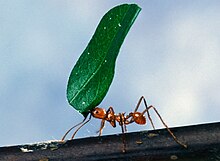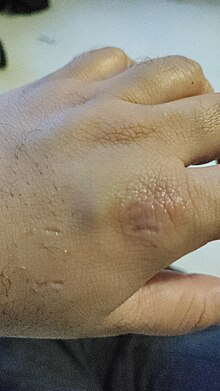Biting

Bitingis an action involving a set of teeth closing down on an object.[1]It is a commonzoologicalbehavior, being found in toothed animals such asmammals,reptiles,amphibians,fish,andarthropods.Biting is also an action humans participate in, most commonly when chewing food.[1]Myocytic contraction of themuscles of masticationis responsible for generating the force that initiates the preparatory jaw abduction (opening), then rapidly adducts (closes) the jaw and moves the top and bottom teeth towards each other, resulting in the forceful action of a bite.[2]Biting is one of the main functions in the lives of larger organisms, providing them the ability to forage,hunt,eat,build,play,fight,protect,and much more. Biting may be a form of physicalaggressiondue to predatory or territorial intentions. In animals, biting can also be a normal activity, being used for eating,scratching,carrying objects, preparing food for young, removing ectoparasites or irritating foreign objects, andsocial grooming.Humans can have the tendency to bite each other whether they are children or adults.[3]
Bites often result in seriouspuncture wounds,avulsion injuries,fractures,hemorrhages,infections,envenomation,anddeath.[4]In modern human societies,dog bitesare the most common type of bite, with children being the most common victims and faces being the most common target.[5]Some other species that may bite humans include urban animals such asferal cats,spiders,andsnakes.Other common bites to humans are inflicted byhematophagousinsects and arthropods, such asmosquitoes,fleas,lice,bedbugs,andticks(whose "bites" are actually a form ofstingingrather than true biting).
Types of teeth[edit]

The types of teeth that organisms use to bite vary throughout theanimal kingdom.Different types of teeth are seen inherbivores,carnivores,andomnivoresas they are adapted over many years to better fit their diets. Carnivores possess canine,carnassial,andmolar teeth,while herbivores are equipped withincisor teethand wide-back molars.[6]In general, tooth shape has traditionally been used to predict dieting habits.[7]Carnivores have long, extremely sharp teeth for both grippingpreyand cutting meat into chunks.[6]They lack flatchewingteeth because they swallow food in chunks. An example of this is shown by the broad, serrated teeth of greatwhite sharkswhich prey on large marine animals.[2]On the other hand, herbivores have rows of wide, flat teeth to bite and chew grass and other plants. Cows spend up to eleven hours a day biting off grass and grinding it with their molars.[8]Omnivores consume both meat and plants, so they possess a mixture of flat teeth and sharp teeth.
Carrying mechanism[edit]

Biting can serve as a carrying mechanism for species such asbeaversandants,the raw power of their species-specific teeth allowing them to carry large objects. Beavers have a large tooth adapted for gnawing wood. Their jaw muscles are tuned to power through big trees and carry them back to their dam.[9]Ants use their powerful jaws to lift material back to the colony. They can carry several thousand times their weight due to their bite and are adapted to use this to forage for their colonies.[10]Fire antsuse their strong bite to get a grip on prey, then inject a toxin via theirstingerand carry the prey back to their territory.[11]
Dangers[edit]
Some organisms have dangerous bites that injectvenom.Manysnakescarry avenomous salivacontaining at least one of the major groups oftoxins,which includecytotoxins,hemotoxins,myotoxins,andneurotoxins.[12]Spider venompolypeptidestarget specificion channels,which excites components of theperipheral,centralandautonomic nervous systems,causing hyperactiveneurotransmitterrelease and subsequentlyrefractoryparalysis.[12]Spider bites,orarachnidism,are mainly a form of predation, but also means of self-defense — when trapped or accidentally tampered with by humans, spiders retaliate by biting.[13]Therecluse spiderandwidow specieshave neurotoxins and necrotizing agents that paralyze and digest prey.[14]
Humans biting each other can cause a number of diseases with streptococci, staphylococci, and anaerobic organisms being very severe causing infections. These bites are typically deep cutting into the skin where the infection forms.[3]
There are several creatures with non-lethal bites that may cause discomfort or diseases.Mosquitobites may causeallergicwhealsthat areitchyand may last a few days; in some areas, they can spreadblood-borne diseases(e.g.malariaandWest Nile fever) viatransmissionofprotozoicorviralpathogens.[15]Similarly,tickbites spread diseases endemic to their location, most famouslyLyme disease,but ticks also serve asdisease vectorsforColorado tick fever,African tick bite fever,Tick-borne encephalitis,etc.[16]
In humans[edit]
Young children who bite others do so out of play or aggression whereas adults bite others out of aggression. Bites that occur from adults fighting are usually on the hands and the skeletal section. Infections are a result of bacteria from the mouth spread to another human and are the third common types of bites that require a hospital visit.[3]Biting in children is common however, it may be prevented by methods including redirection, change in the environment and responding to biting by talking about appropriate ways to express anger and frustration. School-age children, those older than 30 months, who habitually bite may require professional intervention.[17]Some discussion of human biting appears inThe Kinsey Report on Sexual Behavior in the Human Female.[18]Biting may also occur in physical fights or in self-defense.[19]

Criminally,Forensic Dentistryis involved in bite-mark analysis. Because bite-marks change significantly over time, investigators must call for an expert as soon as possible. Bites are then analyzed to determine whether the biter washuman,self-inflicted or not, and whetherDNAwas left behind from the biter. All measurements must be extremely precise, as small errors inmeasurementcan lead to large errors in legal judgment.[20]
Human bites have historically been viewed superstitiously, particularly in theAmerican Southwhere there was once a common belief that the bite of a "blue-gumnegro"(i.e., aBlack personwith darkly pigmentedgums) was lethally poisonous.[21][22][23]
See also[edit]
References[edit]
- ^absearch.credoreference.comhttps://search.credoreference.com/articles/Qm9va0FydGljbGU6NDM5MTEzNg==?q=biting.Retrieved2024-04-25.
{{cite web}}:Missing or empty|title=(help) - ^abFerrara, T.L.; Clausen, P.; Huber, D.R.; McHenry, C.R.; Peddemors, V.; Wroe, S. (2011). "Mechanics of biting in great white and sandtiger sharks".Journal of Biomechanics.44(3): 430–435.doi:10.1016/j.jbiomech.2010.09.028.PMID21129747.
- ^abcsearch.credoreference.comhttps://search.credoreference.com/articles/Qm9va0FydGljbGU6NTc3NDU4?q=behavior%20of%20biting%20in%20adult%20humans.Retrieved2024-04-25.
{{cite web}}:Missing or empty|title=(help) - ^Cherry, James (2014).Feigin and Cherry's textbook of pediatric infectious diseases – Animal and Human Bites, Morven S. Edwards.Philadelphia, PA: Elsevier/Saunders.ISBN978-1-4557-1177-2;Access provided by theUniversity of Pittsburgh
{{cite book}}:CS1 maint: postscript (link) - ^Kenneth M. Phillips (2009-12-27)."Dog Bite Statistics".Archivedfrom the original on 2010-09-21.Retrieved2010-08-06.
- ^abAnimal Teeth | Types of Teeth | DK Find Out. (2018). Retrieved October 28, 2018, fromhttps://www.dkfindout.com/us/animals-and-nature/food-chains/types-teeth/
- ^Sanson, Gordon (2016)."Cutting food in terrestrial carnivores and herbivores".Interface Focus.6(3): 20150109.doi:10.1098/rsfs.2015.0109.PMC4843622.PMID27274799.
- ^Wroe, S.; Huber, D. R.; Lowry, M.; McHenry, C.; Moreno, K.; Clausen, P.; Ferrara, T. L.; Cunningham, E.; Dean, M. N.; Summers, A. P. (2008). "Three-dimensional computer analysis of white shark jaw mechanics: How hard can a great white bite?".Journal of Zoology.276(4): 336–342.doi:10.1111/j.1469-7998.2008.00494.x.
- ^Müller-Schwarze, Dietland (2011)."Form, Weight, and Special Adaptations".The Beaver: Its Life and Impact.Cornell University Press. pp. 11–8.ISBN978-0-8014-6086-9.
- ^Nguyen, Vienny; Lilly, Blaine; Castro, Carlos (2014)."The exoskeletal structure and tensile loading behavior of an ant neck joint".Journal of Biomechanics.47(2): 497–504.doi:10.1016/j.jbiomech.2013.10.053.PMID24287400.RetrievedFebruary 11,2014.
- ^Drees, Bastiaan M. (December 2002)."Medical Problems and Treatment Considerations for the Red Imported Fire Ant"(PDF).Texas A&M University.
- ^abHarris, J. B.; Goonetilleke, A. (2004)."Animal poisons and the nervous system: What the neurologist needs to know".Journal of Neurology, Neurosurgery & Psychiatry.75(Suppl 3): iii40–iii46.doi:10.1136/jnnp.2004.045724.PMC1765666.PMID15316044.
- ^"Workplace Safety & Health Topics Venomous Spiders". cdc.gov. February 24, 2012. Retrieved 28 October 2018
- ^Braitberg, G.; Segal, L. (2009)."Spider bites - Assessment and management".Australian Family Physician.38(11): 862–7.PMID19893831.Archived fromthe originalon 2010-01-07.Retrieved2018-11-19.
- ^"Mosquito Bites",Mayo Clinic,accessed June 28, 2019
- ^"Tickborne Diseases of the United States",The Center for Disease Control,accessed June 28, 2019
- ^Child Care Links, "How to Handle BitingArchivedOctober 7, 2011, at theWayback Machine",retrieved 14 August 2007
- ^Kinsey, Alfred C.; Pomeroy, Wardell B.; Martin, Clyde E.; Gebhard, Paul H.; Brown, Jean M.; Christenson, Cornelia V.; Collins, Dorothy; Davis, Ritchie G.; Dellenback, William (1981).Sexual Behavior in the Human Female.Indiana University Press.ISBN978-0-253-33411-4.JSTORj.ctt173zmgn.
- ^Robsam, Samuel Ohayi; Ihechi, Emeka Udeh; Olufemi, William Odesanmi (March 2018)."Human bite as a weapon of assault".African Health Sciences.18(1): 79–89.doi:10.4314/ahs.v18i1.12.ISSN1680-6905.PMC6016993.PMID29977261.
- ^Shanna Freeman,"How Forensic Dentistry Works",How Stuff Works,accessed June 28, 2019
- ^"Blue Gum Negro".The Intelligencer.19 May 1892. p. 4.
- ^Ogbourn, L. H. (1896)."Gangrene Resulting from Bite of" Blue-Gum "Negro".Atlanta Medical and Surgical Journal (1884).13(2): 103–105.PMC8939548.PMID35829173.
- ^"blue gum(med) adj".
External links[edit]
 Media related toBitingat Wikimedia Commons
Media related toBitingat Wikimedia Commons
